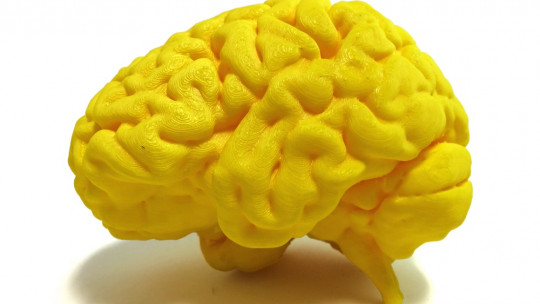Imagine for a moment if every time you interpret a phenomenon or decide to act in a certain way you had to rethink everything completely from the beginning: clearly, you would combine very little! Instead, by retracing each new experience back to the mental patterns you learned in the past, learning and decisions become much faster.
In this way, our brain can think and act quickly, but it tends to remain completely prisoner of the schemes it has built. Precisely, this is the main risk of mental patterns, that is, exchanging one’s own truth for the absolute truth, falling into the trap of cognitive biases and prejudices. In this PsychologyFor article we will discover then how to break mental patterns<
What are mental patterns
Mental patterns are representations of real, hypothetical or imaginary situations of a concept or a reality and the reciprocal functional relationships of its components. A mental pattern of a concept or domain of knowledge consists of a network of elements and connections between them that unconsciously guide reasoning and the acquisition of new data about that domain. Our brain uses mental patterns to:
- Understanding the world around us.
- Interpret what we see or what happens to us.
- Organize our behavior in response to external stimuli.
- Predict what will happen in this or that circumstance.
- Decide what to do to achieve this or that objective.
Theoretical foundations of mental patterns
The first to talk about mental patterns was the Scottish psychologist Kenneth Craick (1943), according to whom the mind constructs small scale models of reality which it uses to predict events, conduct reasoning and found explanations. From this original intuition, cognitive scientists argued that the mind constructs mental patterns as a result of perception, imagination and knowledge, as well as the understanding of language. In this article you will find more information about how the human mind works.
In fact, the construct was developed by the English psychologist Philip Johnson-Laird at the end of the 20th century to describe the results of his experimental research on human language and reasoning, in order to demonstrate the relevant role of semantic information and mental logic in the organization of language and the construction of knowledge.
Mental patterns are psychological basis of understanding and, as Johnson-Laird himself said, if we understand what inflation is, how a certain mathematical proof is carried out, the way the computer works, DNA or divorce, then we must have a mental representation of the considered entities, that is, an internal mental copy that has the same structure of relationships as the phenomenon it represents.
Exercises to change mental patterns
Although mental patterns allow us to understand the world, sometimes they condition and limit us when it comes to making changes. Therefore, it is important to learn to break mental patterns. Next, we will show you different ways to do it.
The first thing is identify your personal standards , that is, become aware of your expectations in life, as they will give you interesting ideas to discover the mental patterns that govern you. To achieve this you can ask yourself the following questions:
- What expectations do you have?
- What do you expect from the job?
- What do you expect from relationships?
- What do you expect from social interactions?
As you answer, pay attention to the words you use, as they may leave some hint of your underlying mental patterns.
Analyze your daily behavior
Examine how your behavioral style develops within the interactions and events that happen to you during the day with these questions:
- What situations cause you the most anxiety and worry?
- Who and what makes you uncomfortable?
- Do you tend to adopt a pessimistic attitude?
- What do you criticize the most about yourself?
- What don’t you dare do that you think you should do?
- What bothers you in other people?
- What do you expect from others?
Then mark the answers on a sheet of paper and try to identify what mental patterns they may hide.
Identify the origin of mental patterns
Observe and analyze how certain mental patterns that you have seen have become ingrained since you were a child. One way to identify where they come from is to ask yourself the following questions:
- What was I told to do and what was I forbidden to do as a child?
- What happened when I disobeyed?
- When and how was I punished?
- What have I done to be accepted?
- What words have been said to me when I have not lived up to other people’s expectations?
- Do you see any connection between the mental patterns you had as a child and the ones you think influence your decisions today?
Many of your mental patterns may have evolved over time and manifest in the present in different ways. Although they are the same as childhood. To modify them you will have to make the effort to go back to the origins<
Identify unnecessary mental patterns for your growth
Another way to break mental patterns is to list the ones that have emerged from the answers to all the questions asked so far. Then you must take these factors into account:
- Degree of rigidity and inadequacy these patterns have.
- Consider whether the schemes are unrealistic and irrational.
- Assess whether these schemes are excessive.
Most unnecessary mental patterns They are caused by your assumptions so it is important to analyze what facts support them and what consequences keeping them alive has for your existence.
Get out of rigid mental patterns
By getting here, now, you will have to understand whether your mental pattern should be maintained or not. To do this, you must assess which one limits you and decide in the most appropriate way whether to maintain it or not. Discover some examples of mental patterns that should be broken:
- Mental scheme that has little to do with logic.
- Rigid and non-adaptive mental scheme.
- Mental scheme that limits your personal development.
The clearer you are about your schemes, the greater the motivation and desire to break mental patterns that no longer serve and incorporate others that are more useful for your growth. In this process, it may be useful for you to consult this article on adapting to change according to psychology.
Highlight the benefits you will obtain
Any action you practice, any belief you have created in your head and any mental scheme you have assumed, has a purpose. Thus, one of the exercises to change mental patterns consists of Consider what benefits you will obtain if you maintain a mental pattern determined and whether these benefits are consistent with your current life situation.
Think about the fact that they may just be small, short-term rewards that hide high emotional costs that will be paid in the near future.
Highlight the possible disadvantages
How to change mental patterns? Focus on the negative consequences which you will face if you continue the path outlined by certain mental schemes. To do this, you must evaluate the following:
- Risks of continuing with the pattern.
- Limitations of not changing the pattern.
- Assess what mental patterns keep you from success.
- Negative impact of certain mental schemes on your life.
- Assess the advantages or disadvantages of keeping specific mental patterns alive.
Using the awareness of possible pain can help you make the changes necessary to improve your life and reprogram negative thought patterns. In this article you will see how to control negative obsessive thoughts.
Develop a more useful mental pattern
Once you have put the previous steps into practice, it is time to build more useful mental patterns and consistent with your current needs and replace the old ones. They must be mental models that maximize the benefits and minimize the disadvantages, in addition to being balanced, flexible and realistic.
An exercise to change mental patterns that can help you in this phase is to describe what your ideal mental pattern would be using flexible and visualize how you would act in different life contexts like at work or with friends.

Practice your new mental pattern
Once you have defined your new mental pattern, make it a habit until it becomes automated< Take the time you need to settle into the new mindset and see if it flows with your daily life. When it comes to knowing if it has really taken hold, you can assess whether your actions reflect this mental pattern and whether the changes in behavior linked to it have improved your quality of life.
This article is merely informative, at PsychologyFor we do not have the power to make a diagnosis or recommend a treatment. We invite you to go to a psychologist to treat your particular case.
If you want to read more articles similar to How to break mental patterns we recommend that you enter our Cognitive Psychology category.
Bibliography
- Bush, S. (2022). Schemi mentali: the foundations of our thoughts
- Elle, A. (2021). Modelli Mentali – Come Utilizzarli Per Potenziare il Pensiero. Retrieved from: https://www.gliaudacidellamemoria.com/modelli-mentali/
- Johnson-Laird, P.N., Girotto, V., Legrenzi, P. (1999). Mental models: an easy guide for the profane. Intelligent system1:63-84.









